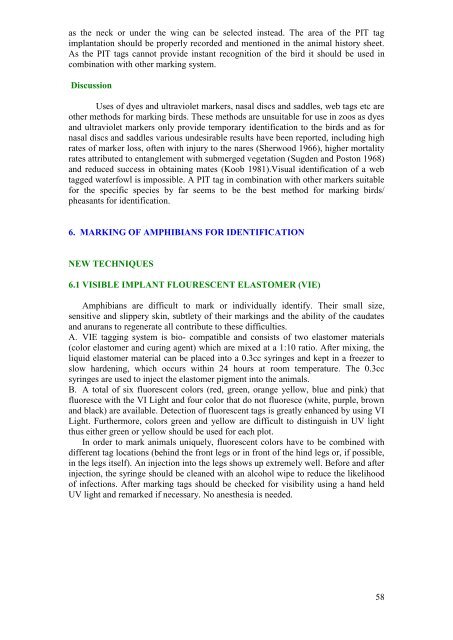standardization of records keeping in indian zoos - Central Zoo ...
standardization of records keeping in indian zoos - Central Zoo ...
standardization of records keeping in indian zoos - Central Zoo ...
Create successful ePaper yourself
Turn your PDF publications into a flip-book with our unique Google optimized e-Paper software.
as the neck or under the w<strong>in</strong>g can be selected <strong>in</strong>stead. The area <strong>of</strong> the PIT tag<br />
implantation should be properly recorded and mentioned <strong>in</strong> the animal history sheet.<br />
As the PIT tags cannot provide <strong>in</strong>stant recognition <strong>of</strong> the bird it should be used <strong>in</strong><br />
comb<strong>in</strong>ation with other mark<strong>in</strong>g system.<br />
Discussion<br />
Uses <strong>of</strong> dyes and ultraviolet markers, nasal discs and saddles, web tags etc are<br />
other methods for mark<strong>in</strong>g birds. These methods are unsuitable for use <strong>in</strong> <strong>zoos</strong> as dyes<br />
and ultraviolet markers only provide temporary identification to the birds and as for<br />
nasal discs and saddles various undesirable results have been reported, <strong>in</strong>clud<strong>in</strong>g high<br />
rates <strong>of</strong> marker loss, <strong>of</strong>ten with <strong>in</strong>jury to the nares (Sherwood 1966), higher mortality<br />
rates attributed to entanglement with submerged vegetation (Sugden and Poston 1968)<br />
and reduced success <strong>in</strong> obta<strong>in</strong><strong>in</strong>g mates (Koob 1981).Visual identification <strong>of</strong> a web<br />
tagged waterfowl is impossible. A PIT tag <strong>in</strong> comb<strong>in</strong>ation with other markers suitable<br />
for the specific species by far seems to be the best method for mark<strong>in</strong>g birds/<br />
pheasants for identification.<br />
6. MARKING OF AMPHIBIANS FOR IDENTIFICATION<br />
NEW TECHNIQUES<br />
6.1 VISIBLE IMPLANT FLOURESCENT ELASTOMER (VIE)<br />
Amphibians are difficult to mark or <strong>in</strong>dividually identify. Their small size,<br />
sensitive and slippery sk<strong>in</strong>, subtlety <strong>of</strong> their mark<strong>in</strong>gs and the ability <strong>of</strong> the caudates<br />
and anurans to regenerate all contribute to these difficulties.<br />
A. VIE tagg<strong>in</strong>g system is bio- compatible and consists <strong>of</strong> two elastomer materials<br />
(color elastomer and cur<strong>in</strong>g agent) which are mixed at a 1:10 ratio. After mix<strong>in</strong>g, the<br />
liquid elastomer material can be placed <strong>in</strong>to a 0.3cc syr<strong>in</strong>ges and kept <strong>in</strong> a freezer to<br />
slow harden<strong>in</strong>g, which occurs with<strong>in</strong> 24 hours at room temperature. The 0.3cc<br />
syr<strong>in</strong>ges are used to <strong>in</strong>ject the elastomer pigment <strong>in</strong>to the animals.<br />
B. A total <strong>of</strong> six fluorescent colors (red, green, orange yellow, blue and p<strong>in</strong>k) that<br />
fluoresce with the VI Light and four color that do not fluoresce (white, purple, brown<br />
and black) are available. Detection <strong>of</strong> fluorescent tags is greatly enhanced by us<strong>in</strong>g VI<br />
Light. Furthermore, colors green and yellow are difficult to dist<strong>in</strong>guish <strong>in</strong> UV light<br />
thus either green or yellow should be used for each plot.<br />
In order to mark animals uniquely, fluorescent colors have to be comb<strong>in</strong>ed with<br />
different tag locations (beh<strong>in</strong>d the front legs or <strong>in</strong> front <strong>of</strong> the h<strong>in</strong>d legs or, if possible,<br />
<strong>in</strong> the legs itself). An <strong>in</strong>jection <strong>in</strong>to the legs shows up extremely well. Before and after<br />
<strong>in</strong>jection, the syr<strong>in</strong>ge should be cleaned with an alcohol wipe to reduce the likelihood<br />
<strong>of</strong> <strong>in</strong>fections. After mark<strong>in</strong>g tags should be checked for visibility us<strong>in</strong>g a hand held<br />
UV light and remarked if necessary. No anesthesia is needed.<br />
58
















